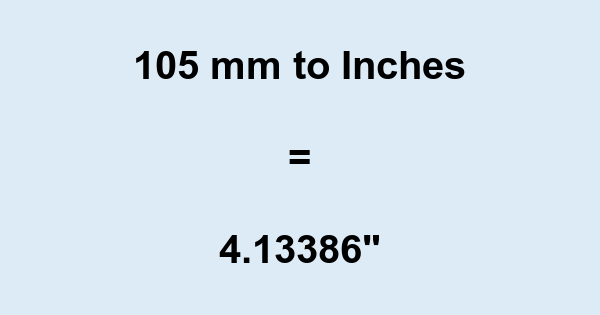Are 105mm to inches you curious about how to convert 105mm to inches? Look no further! In this blog post, we will explore the key points about converting millimeters (mm) to inches and provide you with a simple conversion formula. Whether you’re a student, DIY enthusiast, or just someone who loves numbers, understanding this conversion can come in handy in various situations. So let’s dive right in and uncover the secrets of converting 105mm to inches!
How many inches are in 105mm?
Have you ever wondered how many inches are in 105mm? Well, let’s find out! To determine the number of inches, we need to apply a conversion factor.
There are approximately 25.4 millimeters in one inch. So if we divide 105 by 25.4, we can calculate the equivalent measurement in inches.
Using a calculator or doing the math manually, when we divide 105 by 25.4, we get approximately 4.13 inches as our result.
Now that we know there are roughly 4.13 inches in 105mm, it becomes easier to visualize and compare measurements across different units.
Converting between millimeters and inches is particularly useful when working with international standards or dealing with equipment that uses different unit systems.
So whether you’re designing something new or simply trying to understand dimensions provided in mm, knowing how to convert from millimeters to inches can be a handy skill to have!
Keep reading for more information on how to convert mm to inches using a simple formula and some real-world examples that will help solidify your understanding of this conversion process!
What is the conversion formula for mm to inches?
The conversion formula for millimeters (mm) to inches is a simple one. To convert from mm to inches, you just need to divide the number of millimeters by 25.4. This is because there are 25.4 millimeters in one inch.
So, if you have a measurement of 105mm and you want to know how many inches that is, all you have to do is divide 105 by 25.4. This will give you the equivalent measurement in inches.
Using this formula, we can easily convert any measurement from mm to inches. Whether it’s for woodworking projects or international unit conversions, knowing how to convert between these two units can be very useful.
It’s important to note that when converting measurements, it’s always a good idea to round your answer appropriately based on the level of precision required for your specific application.
Now that we understand the conversion formula for mm to inches, let’s take a look at some examples of converting specific measurements!
How to convert 105mm to inches using the formula
To convert 105mm to inches, you can use a simple conversion formula. The formula is: inches = millimeters / 25.4.
So, if we want to convert 105mm to inches using this formula, we would divide 105 by 25.4. Doing the math, we get approximately 4.13 inches.
Now that you know the conversion formula and how to use it, let’s look at a few examples of converting mm to inches:
– If you have 50mm and want to convert it to inches, divide 50 by 25.4 which equals approximately 1.97 inches.
– Let’s say you have a measurement of 75mm that needs to be converted into inches. Divide 75 by the conversion factor of 25.4 and you’ll get around 2.95 inches.
As you can see, converting mm to inches is quite straightforward once you know the formula and have a calculator handy! So next time someone asks about converting millimeters into this imperial unit of length, now you’ll be able to help them out with confidence!
A few example conversions from mm to inches
Now, let’s take a look at a few examples of converting millimeters to inches. Remember, the conversion factor is 25.4, as we mentioned earlier.
For instance, if you have a measurement of 210mm and want to know how many inches that is, simply divide it by 25.4:
210 mm ÷ 25.4 = 8.27 inches
So, in this case, 210mm is approximately equal to 8.27 inches.
Another example could be converting a measurement of 450mm to inches:
450 mm ÷ 25.4 =17.72 inches
Therefore, when you have a length of 450mm, it is equivalent to about 17.72 inches.
Let’s do one more example just for good measure – say we have the measurement of an object as being exactly1000mm long:
1000 mm ÷25.4=39 .37inches
So if something measures exactly1000mm in length , then its length can be described as roughly39 .37inches.
As you can see from these examples , the process involves dividing the given number by the conversion factor ( which is always24 .5)to obtain your answer in inches.
This allows us to easily convert any millimeter value into its corresponding inch measurement without too much hassle or confusion.
Conclusion
Conclusion
Understanding the conversion from millimeters to inches can be a useful skill when working with different measurement systems. By knowing that there are 25.4 millimeters in one inch, you can easily convert between the two units.
For example, if you have a measurement of 105mm and want to know its equivalent in inches, simply divide it by 25.4. This will give you approximately 4.1346 inches.
It’s important to remember that conversions may result in decimal values due to the differing precision between millimeters and inches. However, these decimal values can still provide accurate measurements for various purposes.
So whether you’re dealing with dimensions for woodworking projects or trying to understand specifications on international products, being able to convert mm to inches will come in handy.
With this knowledge, you’ll be able to navigate between metric and imperial systems effortlessly and ensure accurate measurements every time.
So go ahead and put your newfound conversion skills into practice!











